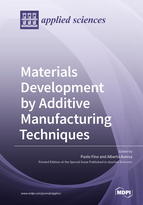Materials Development by Additive Manufacturing Techniques
A special issue of Applied Sciences (ISSN 2076-3417). This special issue belongs to the section "Materials Science and Engineering".
Deadline for manuscript submissions: closed (31 March 2020) | Viewed by 38376
Special Issue Editors
Interests: research and development of new alloys for additive manufacturing processes
Special Issues, Collections and Topics in MDPI journals
Interests: metallic materials; additive manufacturing
Special Issues, Collections and Topics in MDPI journals
Special Issue Information
Dear Colleagues,
Nowadays, metal additive manufacturing (AM) processes have a great impact on several industrial production processes. The reasons for the success of these technologies are mainly related to their possibility to build complex shapes, customized parts, and lightweight components.
However, AM technologies also bring many advantages from a material perspective. The high cooling rate causes the solidification of peculiar microstructures, as well as interesting mechanical properties. Nonetheless, some high-strength alloys are not processable by AM. It is therefore fundamental to develop high-strength alloys that can be processed by AM and can take advantage of the unique solidification conditions that arise during the building process.
This Special Issue will address the advancements in AM alloys’ design and characterization.
Potential topics include, but are not limited to, the following:
- New methodology for materials additive manufacturing development;
- New materials for additive manufacturing;
- Advanced characterizations of AM materials;
- Microstructural features of AM materials;
- Properties of AM materials;
- Materials modeling for AM development
Prof. Paolo Fino
Dr. Alberta Aversa
Guest Editors
Manuscript Submission Information
Manuscripts should be submitted online at www.mdpi.com by registering and logging in to this website. Once you are registered, click here to go to the submission form. Manuscripts can be submitted until the deadline. All submissions that pass pre-check are peer-reviewed. Accepted papers will be published continuously in the journal (as soon as accepted) and will be listed together on the special issue website. Research articles, review articles as well as short communications are invited. For planned papers, a title and short abstract (about 100 words) can be sent to the Editorial Office for announcement on this website.
Submitted manuscripts should not have been published previously, nor be under consideration for publication elsewhere (except conference proceedings papers). All manuscripts are thoroughly refereed through a single-blind peer-review process. A guide for authors and other relevant information for submission of manuscripts is available on the Instructions for Authors page. Applied Sciences is an international peer-reviewed open access semimonthly journal published by MDPI.
Please visit the Instructions for Authors page before submitting a manuscript. The Article Processing Charge (APC) for publication in this open access journal is 2400 CHF (Swiss Francs). Submitted papers should be well formatted and use good English. Authors may use MDPI's English editing service prior to publication or during author revisions.
Keywords
- Metal additive manufacturing
- Mechanical properties
- Alloys development
- Powder production
- Microstructure







